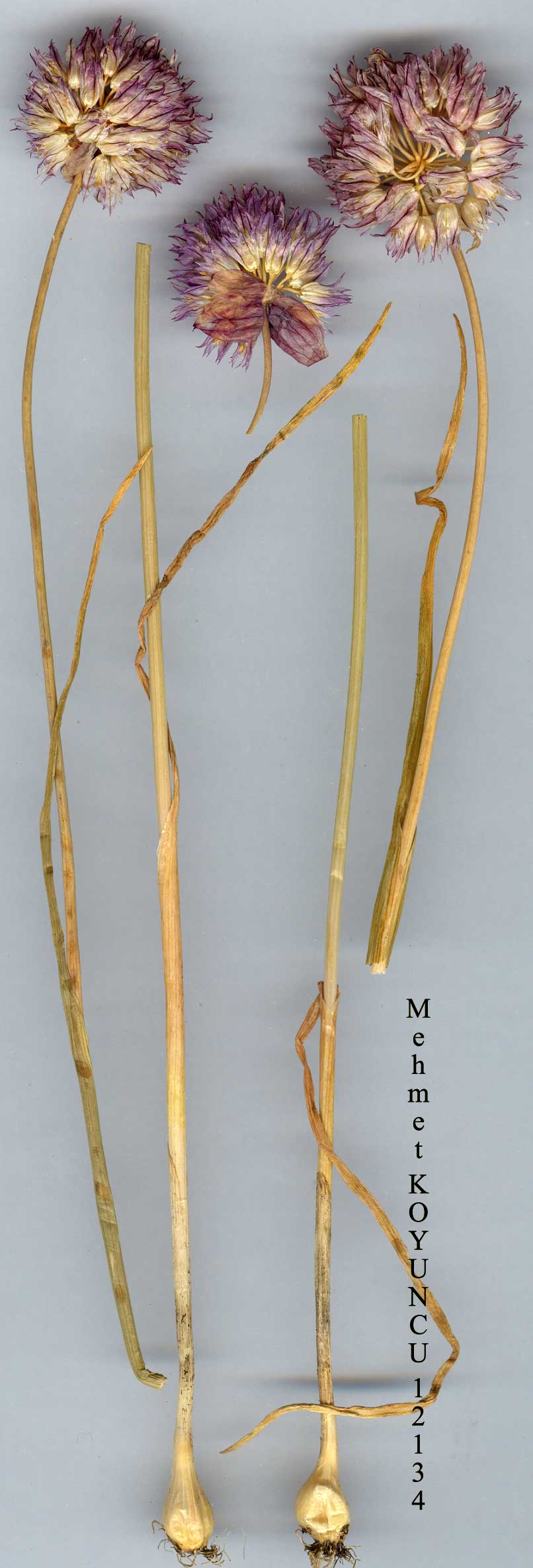| Liliaceae |
|---|

Allium aucheri BOISS. |

Allium aucheri BOISS. |

Allium aucheri BOISS. |
 Allium aucheri BOISS. |
Allium L. |
A. aucheri Boiss., Diagn. ser. 1(7):116 (1846). Syn: A. carduchorum C. Koch in Linnaea 22:237 (1849); A. brevipes Ledeb., Fl. Ross. 4:165 (1852); A. caerulescens Boiss., Diagn. ser. 2(4):115(1859)nom.illegit.! ?A.ledschan-ense Conrath & Freyn in Bull. Herb. Boiss. 4:190 (1896)! A. cyclospathum Freyn in Bull. Herb. Boiss. ser. 2, 1:288 (1901)! Ic: Fl. URSS 4: t. 14 f. 3 (1935); Rech. fil., FL Iraniea 76: t. 5 f. 66 (1971). Figure 7. Map 29.
Bulb ovoid, (0.5-)0.8-1 cm diam.; outertunics greyish-brown, subcoriaceous. Stems 40-70(-80) cm. Leaves 2-4, fistulose, 1.5-3(-4) mm broad, flattened,short. Spathe dark violet or purple, globose, suddenly contracted into a beak as long as base, dividing into triangular-ovate, acute valves. Umbel spherical or hemispherical, 2-3 cm diam., many-flowered, dense, almost capitate. Pedicels unequal, 0.5-2 x perianth. Perianth tubuiar-campanulate; segments dark violet-blue or violet-pink with dirty purple or green midvein, 7-9 mm, oblong-elliptic, acute and cucullate at apex, smooth or denticulate-scabxid oa keel. Filaments 1/3-1/2 x perianth segments, ± ciliste at base; median cusp of inner filaments 1/6-1/4 x basal lamina and 1/3-1/2 x lateral cusps. Capsule ellipsoid, c. 6 mm. Fl. 6-7. Meadows, summer pastures, damp places, dry grassy banks, c. 1800-2550 m. Syntypes: [Turkey B7?] Armenia, Aucher 2192 (G!); [Iran] in Persiae prov. Ghilan, Aucher 5385 (G!). E. Anatolia. Aβ Erzurum: nr Erzurum, Calvert! A9 Kars: Yağmurlu Da., between Sarikamiş, and Karaurgan, 2300 m, D. 30813! B9 Van: Warack (Erek) Da., 2500 m, Kronenburg 69 (type of A. cyclospathum)1. Transcaucasia, Iran. Ir.-Tur. element. The type specimen of A. ledschan-ense Conrath & Freyn from the Caucasus does not seem to differ from A. aucheri in leaf shape, umbel or perianth, although Grossheim (Fl. Kavk. ed. 2, 2:269, 1940) differentiates A. ledschanense from A. aucheri by its flat (not semicylindrical) leaves. Freyn differentiated A. cyclospathum from A. aucheri mainly by lower stature, smaller spathe and umbel, and white perianth segments of different shape. Thetypeof A. cyclospathum,however, is merely a young, undeveloped specimen of A. aucheri; in young, not fully open umbels of this species the perianth segments often appear white. |